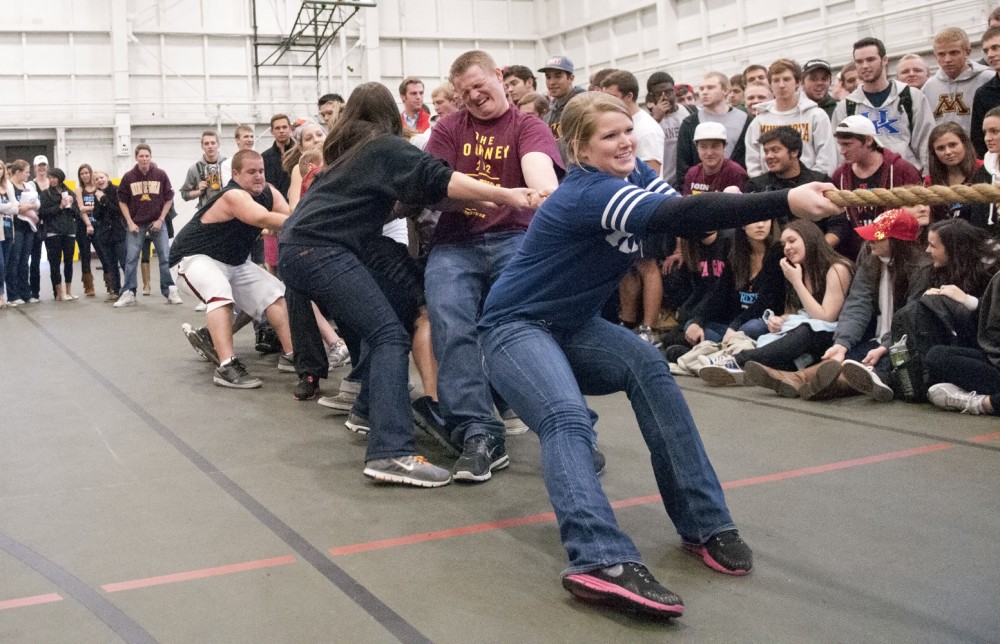A Field House full of spectators and a tug-of-war contest Monday night kicked off the greek portion of Spring Jam, the annual campus music festival at the University of Minnesota.
Every year, the greek community organizes a week of fundraising events prior to the Spring Jam weekend.
“I heard it’s the best week of the year,” said Molly Hollway, a freshman from the Alpha Phi sorority.
Spring Jam has been a University tradition for 15 years, but its roots go back nearly a century. The greek community has been involved since the 1940s.
A lot has changed since the event first began but not the goal: to bring the campus together and raise money for a worthwhile cause.
Clowns got it started
It started in the spring of 1913 with a University-wide circus fundraiser that featured acrobatic and tumbling acts, animals and a “cowboy quintet,” according to an April 1963 Minnesota Daily article, stored in the University archives.
For the next three decades, the University periodically held the event but couldn’t establish it as an annual tradition.
But in 1947, the Campus Carnival became a part of University life. Planned by the Alpha Phi Omega fraternity, the first “carni” was established as a scholarship fundraising event. It featured entries of two student organizations, like men’s and women’s dormitories and fraternities, working together to put on a show or concession.
Money raised in the early years went to a range of beneficiaries within the University, mainly for scholarships. In later years, the money was given to charities like the Viking’s Children Fund. In 1948, the one-day event raised $5,000 (full-time undergraduate tuition cost about $100 at the time). By the end of the 1950s, the carnival involved nearly 70 student organizations and raised nearly $20,000.
But raising money wasn’t the only thing for which the carnival was known. Entries competed for an All-Participants Trophy, awarded to the chapter that accumulated the most points through ticket sales and TV appearances.
The event expanded exponentially in the 1970s and 1980s.
In 1976, the carnival moved from one Saturday evening to a three-night event beginning on a Thursday.
The presentation of the entries became progressively more elaborate, with large stages, flashing lights, music and costumes, making everything come to life in the Field House.
Football games, stabbings and riots
There was controversy throughout the years, having been almost canceled twice and then reduced in length in 2010.
In 1956, the event was nearly canceled because of a conflict with the University’s spring football game. Five years later, police got involved after a dispute broke out at Coffman Union over which student organization was in line first to register for the carnival.
In 1972, Campus Carnival was renamed University Fair, but that change only lasted a year.
In 1986, a new floor in the Field House and increased insurance costs for the University left students wondering if the carnival had seen its last days. But a promise to carefully use the building resolved any concerns of causing damage.
A stabbing of a Psi Upsilon fraternity member at a post-Carnival party in 1988 spurred talks of cancelation and some big changes. The greek community withdrew from the carnival and created its own event called May Daze. But both events faltered, and the greek community rejoined the University the following year.
But by then, the carnival’s end was near. In 1989 and 1990, the carnival did not make any charitable contributions. The University decided to no longer provide the Field House as a venue and security, sealing the carnival’s fate.
So in 1991, the greek community created the Rites of Spring, which included a Dinkytown block party as one of its highlights.
There was hope that the event would become as popular as the carnival, but it never reached the level of campus involvement of its predecessor.
‘Carni’ incarnate
Spring Jam started in 1997, said Beth Youngblom, one of this year’s three Spring Jam chairs. Musical performances became the focus instead of games and concessions.
Until recently, Spring Jam was six days long but riots in Dinkytown in 2009 led the University to condense it.
This year’s event still has historical ties to those that took place at the University over the decades. Though the Field House has been replaced by Coffman Union, and concerts and band competitions have replaced the elaborate stages and costumes, the event still serves its original purpose of bringing the campus together and celebrating the end of a long winter.
“The most value this event really brings is … the fact that it’s at the end of the semester,” said Xander Castro, who was a Spring Jam chair last year. “It’s kind of a nice tribute to the entire semester.”











